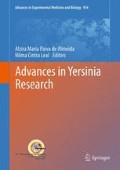Abstract
The purpose of this study was to evaluate the presence of Yersinia enterocolitica 4/O:3 in the pork production chain, at slaughterhouses and markets in Brazil. Out of 792 samples, 320 were bioserotyped as Y. enterocolitica 4/O:3. Of these, 1.66% (2/120) originated from slaughterhouse environments and 30% (144/480) from tongue and tonsil samples. Eighty-four of these isolates were analyzed by pulsed-field gel electrophoresis (PFGE) using NotI, and 15 different Y. enterocolitica 4/O:3 PFGE patterns (PYA to PYP) were obtained. PYA and PYB were the most frequent and included almost all human isolates. Although Y. enterocolitica in the pork production chain does not appear to cause many human infections in Brazil, there is still a chance for contamination, so good manufacturing practices should be adopted by the markets and by consumers at home, in order to minimize the spread of Y. enterocolitica 4/O:3.
Access this chapter
Tax calculation will be finalised at checkout
Purchases are for personal use only
References
Asplund K, Tuovinen V, Veijalainen P, Hirn J (1990) The prevalence of Yersinia enterocolitica O:3 in Finnish pigs and pork. Acta Vet Scand 31:39–43
Boer E, Nouws JFM (1991) Slaughter pigs and pork as a source of human pathogenic Yersinia enterocolitica. Int J Food Microbiol 12:375–378
Bottone EJ (1997) Yersinia enterocolitica: the charisma continues. Clin Microbiol Rev 10:257–276
European Food Safety Agency (EFSA) (2009) The community summary report on trends and sources of zoonosis, zoonotic agents in the European Union in 2007. EFSA J 223:189–191
Falcão JP, Falcão DP, Pitondo-Silva A et al (2006) Molecular typing and virulence markers of Yersinia enterocolitica strains from human, animal and food origins isolated between 1968 and 2000 in Brazil. J Med Microbiol 55:1539–1548
Fredriksson-Ahomaa M, Korte T, Korkeala H (2000) Contamination of carcasses, offals, and the environment with yadA-positive Yersinia enterocolitica in a pig slaughterhouse. J Food Prot 63:31–35
Fredriksson-Ahomaa M, Bucher M, Hank C et al (2001a) High prevalence of Yersinia enterocolitica 4 O:3 on pig offal in Southern Germany: a slaughtering technique problem. Syst Appl Microbiol 24:457–463
Fredriksson-Ahomaa M, Hallanvuo S, Korte T et al (2001b) Correspondence of genotypes of sporadic Yersinia enterocolitica bioserotype 4/O:3 strains from human and porcine sources. Epidemiol Infect 127:37–41
Fredriksson-Ahomaa M, Koch U, Klemm C et al (2004) Different genotypes of Yersinia enterocolitica 4/O:3 strains widely distributed in butcher shops in the Munich area. Int J Food Microbiol 95:89–94
Fredriksson-Ahomaa M, Stolle A, Korkeala H (2006) Molecular epidemiology of Yersinia enterocolitica infections. FEMS Immunol Med Microbiol 47:315–329
Fredriksson-Ahomaa M, Stolle A, Stephan R (2007) Prevalence of pathogenic Yersinia enterocolitica in pigs slaughtered at a Swiss abattoir. Int J Food Microbiol 119:207–212
Fredriksson-Ahomaa M, Meyer C, Bonke R et al (2010) Characterization of Bavarian slaughter pigs. Lett Appl Microbiol 50:412–418
Fukushima H, Gomyoda M, Aleksic S et al (1993) Differentiation of Yersinia enterocolitica serotype O:5, 27 strains by phenotypic and molecular techniques. J Clin Microbiol 31:1672–1674
Gürtler M, Alter T, Kasimir S et al (2005) Prevalence of Yersinia enterocolitica in fattening pigs. J Food Prot 68:850–854
Hariharan H, Giles JS, Heaney SB et al (1995) Isolation, serotypes, and virulence-associated properties of Yersinia enterocolitica from the tonsils of slaughter hogs. Can J Vet Res 59:161–166
Hofer E, Lázaro NS (1997) Anti-Yersinia enterocolitica serotype 3 agglutinins in swine sera from Rio de Janeiro. Pesqui Vet Bras 17:9–11
Kapperud G (1991) Yersinia enterocolitica in food hygiene. Int J Food Microbiol 12:53–66
Kapperud G, Nesbakken T, Aleksic S et al (1990) Comparison on restriction endonuclease analysis and phenotypic typing methods for differentiation of Yersinia enterocolitica isolates. J Clin Microbiol 28: 1125–1131
Lambertz ST, Danielsson-Tham M-L (2005) Identification and characterization of pathogenic Yersinia enterocolitica isolates by PCR and pulsed-field gel electrophoresis. Appl Environ Microbiol 71:3674–3681
Nesbakken T (1988) Enumeration of Yersinia enterocolitica O:3 from the porcine oral cavity, and its occurrence on cut surfaces of pig carcasses and the environment in a slaughterhouse. Int J Food Microbiol 6:287–293
Nesbakken T, Iversen T, Eckner K et al (2006) Testing of pathogenic Yersinia enterocolitica on the natural dynamic of infection. Int J Food Microbiol 111: 99–104
Rosner BM, Stark K, Werber D (2010) Epidemiology of reported Yersinia enterocolitica infections in Germany, 2001–2008. BMC Public Health 10:337
Sihvonen LM, Toivonen S, Haukka K et al (2011) Multilocus variable-number tandem-repeats analysis, pulsed-field gel electrophoresis, and antimicrobial susceptibility patterns in discrimination of sporadic an outbreak-related strains of Yersinia enterocolitica. BMC Microbiol 11:42
Teodoro VAM, Pinto PSA, Vanetti MCD et al (2006) Aplicação da técnica de PCR na detecção de Yersinia enterocolitica em suínos abatidos sem inspeção. Arq Bras Med Vet Zootec 58:9–14
Toora S, Budu-Amoako E, Ablett RF et al (1994) Isolation of Yersinia enterocolitica from ready-to-eat foods and pork by a simple two step procedure. Food Microbiol 11:369–374
Wauters G, Kandolo K, Janssens M (1987) Revised biogrouping scheme of Yersinia enterocolitica. Contrib Microbiol Immunol 9:14–21
Acknowledgements
We thank FAPESP for financial support (process 06/55501-0); Juliana Pfrimer Falcão (PhD) from FCFRP-USP, for kindly providing the human clinical isolates; and Deyse Cristhina Vallim da Silva and André Victor Barbosa, from FIOCRUZ-RJ, for bioserotyping.
Author information
Authors and Affiliations
Corresponding author
Editor information
Editors and Affiliations
Rights and permissions
Copyright information
© 2012 Springer Science+Business Media New York
About this paper
Cite this paper
Paixão, R., de Gobbi, D.D.S., Raimundo, D.C., Hofer, E., Matte, M.H., Moreno, A.M. (2012). Characterization of Yersinia enterocolitica 4/O:3 Isolated from Slaughterhouses and Pork in the State of São Paulo, Brazil, and Clinical Cases in Humans. In: de Almeida, A., Leal, N. (eds) Advances in Yersinia Research. Advances in Experimental Medicine and Biology, vol 954. Springer, New York, NY. https://doi.org/10.1007/978-1-4614-3561-7_15
Download citation
DOI: https://doi.org/10.1007/978-1-4614-3561-7_15
Published:
Publisher Name: Springer, New York, NY
Print ISBN: 978-1-4614-3560-0
Online ISBN: 978-1-4614-3561-7
eBook Packages: Biomedical and Life SciencesBiomedical and Life Sciences (R0)

